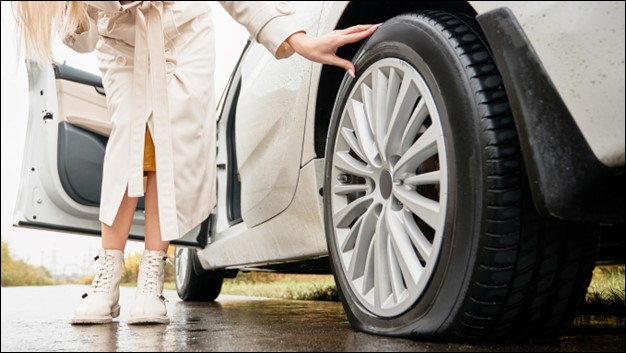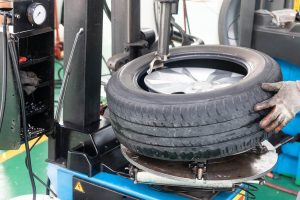A flat car tyre (tayar pancit), an inconvenience that many drivers experience at some point in their lives. If you’re lucky, a tyre shop can provide roadside tyre-changing services.
This unfortunate event not only disrupts people’s lives but also emphasizes the importance of proper maintenance and preparation of vehicles on the road.
By understanding the ins and outs of a flat tyre, we can equip ourselves with the knowledge and skills needed to minimize the impact and confidently navigate to get through this unexpected situation.
In today’s article, we will explore the causes of flat tyres and discuss how to change a car tyre easily.
Causes of flattened and easy-to-break tyres
- Under-inflated tyres
- Frequently hitting sharp objects
- Bent car rims
- Driving fast on potholed or uneven roads
- Small stones tucked into the tyre interstices
If you have ever hit a pothole on the road and heard a sound you’ve never heard before, and your car’s steering is uncontrollable, you need to take it seriously as a sudden tyre blowout or flat tyre may occur, leading to a potential road accident.
Ensure you regularly check the condition of your car tyres to prevent any unwanted incidents. You should have a spare tyre available for emergencies.
Spare tyres can be found at affordable tyre shops, but if you prefer quality tyres, you can get them at higher-end tyre shops. The cost of a spare tyre is usually not too high, so you don’t need to worry about spending too much on your tyres later.
Before you want to change a car tyre, you need some tools, such as:
- Spare tyre
- Jack to lift the car
- Jack handle
- Lug Wrench
- Spanner
Proper and Easy Steps to Change a Car Tyre
If your car tyre is deflating or starting to leak while driving, stay calm, control the steering, and gently apply the brakes. By following the detailed instructions below, you will be able to replace a damaged, punctured, or flat tyre effectively.
Step 1: Stop in a Safe Location
If your car tyre suddenly goes flat or punctures while driving, pull over to a safe location, such as the roadside or a crowded area. If possible, avoid stopping in a quiet area.
Before changing the tyre, make sure the car is parked on a level and stable surface. An uneven road surface can cause your car body to fall or slip off the car jack.
For your safety, turn on the hazard lights and place a warning triangle or kit at least 45 meters behind the rear of your vehicle.
Step 2: Prepare the Necessary Equipment
Before starting the flat tyre-changing process, remove the spare tyre or replacement tyre and other necessary tools from your car.
To change or replace a car tire, you need several essential tools. A car jack, typically a scissor jack, is necessary for lifting the car, and a lug wrench is used to remove the tire nuts. You should have a spare tire, which is usually smaller and not meant for high-speed driving. Modern cars may lack a spare, so a tire repair kit is advisable. For cars with specific wheel nuts, a wheel nut key is needed. Additionally, gloves protect your hands, a flashlight aids nighttime changes, and a reflective vest ensures visibility in the dark.
If unsure, you can refer to your car’s manual to find out where these tools are stored in your car. However, these tools are usually kept in the lower back part of the boot space in your car.
Step 3: Loosen the Tyre Nut
Use the lug wrench to remove the tyre nut or screw. However, as mentioned above, make sure to place your car on a flat surface first to prevent your car from falling or slipping off the car jack during the tyre-changing process.
Step 4: Jack Up the Car
If not sure, refer to the manual to find the appropriate location to place the car jack. Usually, the car jack is placed near your car tyre.
Do not jack up your car too high to avoid the risk of the car falling or slipping—just enough so that the car tyre can be rotated.
Step 5: Change the Car Tyre
Remove or take out the tyre by turning the nut counterclockwise (anticlockwise). Then, pull out the tyre from the car. Replace it with the spare tyre and tighten the tyre nut again.
Step 6: Tighten the Tyre Nut
Lower your car again. Then, step on the lug wrench with your foot to ensure a tight and secure screw grip. You are also advised to tighten the tyre nut diagonally.
Step 7: Replace the Spare Tyre Immediately
After changing the spare tyre as your car tyre, you are advised to replace your car tyre immediately. This is because the spare tyre can only travel an average of 80 km to 113 km at a maximum speed of 80 km/h.
In general, driving fast or exceeding the recommended distance when using a spare tyre can increase the risk of accidents, such as tyre blowouts, and so on.
Therefore, you are advised to consider the following for your safety.
Is It Safe to Drive Using a Spare Tire?
Spare tires, also known as donuts or emergency tires, are smaller and designed for temporary use during emergencies like flat or punctured tires. They allow you to drive to a nearby workshop for repairs or replacement. While they are effective for short distances and lower speeds, it’s crucial to replace them with a regular tire as soon as possible to ensure safe driving conditions.
Safe Driving Tips When Using a Spare Tire
- Drive Slowly and Cautiously: Spare tires are not intended for prolonged use or high speeds. Keep your speed under 80 km/h and use the leftmost lane for safety.
- Check Tire Pressure Regularly: Ensure the spare tire is properly inflated, typically around 60 PSI, to avoid issues when you need to use it. Regular checks can prevent inconvenient surprises.
Conclusion
Experiencing a flat tyre (tayar pancit) can be a troublesome situation. However, it is important to remain calm and do the necessary to address the issue immediately.
By following the steps and methods discussed above and utilizing the available equipment or tools, you can effectively handle flat tyres and continue your journey without further delay.





